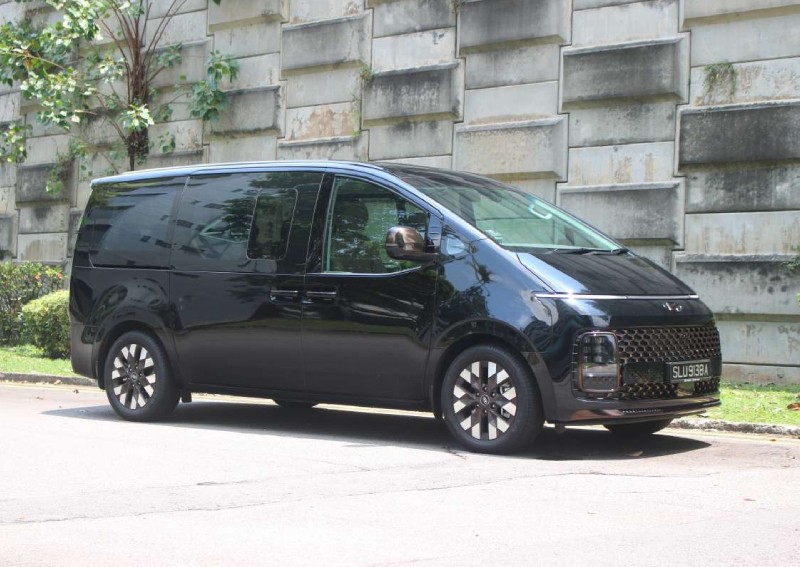2022 Hyundai Staria review: Space bus


MPVs have a reputation for being rather humdrum and boring vehicles, but the Hyundai Staria is proof that a family van need not look like a literal box on wheels. I mean, just look at it.
The Staria’s futuristic styling feels quite other-worldly, with its egg-shaped profile, thin LED light bar up front, bronze-accented details, and large glasshouse leading some to liken it to a spaceship. It’s hard to imagine a people carrier attracting stares from curious passers-by, but the Staria’s looks are truly one-of-a-kind.

The wacky design also serve as a bit of a distraction to hide its bulk too, at least in pictures anyway, for the Staria is freaking massive when you see it in the metal. The car is 5,253mm long, 1,997mm wide and 1,990mm tall, which makes it an absolute beast of a vehicle.
It also means that piloting the Staria through a multi-storey carpark can become a butt-clenching affair, as you constantly sweat over whether this sizeable van will be able to navigate through these urban obstacle courses and emerge unscathed.

There’s a price to pay for all that heft though, and that is through the driving experience. There’s no escaping the Staria’s bus-like demeanour, with the car requiring extra care when manoeuvring around town. U-turns become somewhat ponderous to execute, and you find yourself taking an extra second or two to ensure there’s no errant traffic hiding in your blind spot before pulling out.
The problem is slightly exacerbated by a drivetrain does sometimes struggle to keep up. On paper, the 3.5-litre V6, which produces 272hp and 331Nm of torque, seems pretty adequate.
But then it has to lug 2.2-tonnes of MPV around, and while you’ll get to triple digit speeds eventually (Hyundai claims a 0-100km/h time of 8.9 seconds), it’s not something that you’ll feel at ease with sustaining for long distances. If you’ve ever experienced a heavy-duty vehicle like a bus or lorry at high speeds, then you’ll get the idea.

The Staria then is much more at home just plodding along at more pedestrian speeds. And to that end, it truly excels in terms of refinement and comfort. The suspension setup copes reasonably well over most surfaces, with the only exception being that the car will jolt uneasily if you go over bumps at a higher rate of speed, but that’s just down to physics really given the Staria’s mass and dimensions.
Clearly then, the Staria is not much of a driver’s car, but it’s truly a different story for passengers. Given its size, it’s no surprise to find that there’s plenty of space for folks in the second, and even the third, rows to stretch out their legs.
The second row seats are reclinable captain chairs that come with heating and cooling functions, as well as four-way adjustable leg rests, which are indulgences that you’ll generally find in luxury limousines. The third row is a mere three-person bench, but as mentioned, there’s plenty of room back there too.

Elsewhere, the Staria is reasonable well-equipped, and it comes standard with stuff such as a 360-degree view camera (somewhat useful for helping the Staria squeeze through tight spaces), and a bunch of driver assistance features like forward collision assist, adaptive cruise control, and lane keeping assist.

There are also endless amounts of storage spaces, perfect for hiding your bits and bobs from your, ahem, shopping trip to Malaysia. Oddly though, it is missing a few features that are commonly found in lesser cars, such as automatic wipers and memory seats. The 8.0-inch infotainment touchscreen also seems a bit small, although it does come with Apple CarPlay and Android Auto.

To be fair, if you’re looking for a gigantic bus to lug your family around in comfort, there are a number of alternatives in the market that’s worth consideration. The Staria’s fellow Korean offering, the Kia Carnival, feels equally cavernous, with the benefit of a lower ride height to make entering carparks less of a headache.
The Toyota Alphard is fairly similar in stature to the Staria, but brings with it a slightly more prestigious image with the backing of the Toyota name.
But neither of them looks like a spaceship though, so if anything, the Staria has the upper hand if you want a family van that has the same kind of visual appeal of a supercar. For that alone, the Staria stands in a class of its own.
Hyundai Staria

| Drivetrain type | Petrol engine |
| Engine | 3,470cc, V6 |
| Power | 272hp at 6400rpm |
| Torque | 331Nm at 5000rpm |
| Gearbox | 8-speed automatic |
| 0-100km/h | 8.9 seconds |
| Top Speed | 210km/h |
| VES Banding | C2 / +S$25,000 |
| Fuel Efficiency | 11.1L/100km |
| Agent | Komoco Motors |
| Price | S$246,999 with COE |
| Availability | Now |
| Verdict: | Eye-catching Staria van is enormous and amazingly plush for passengers, but the driving experience is somewhat utilitarian |
This article was first published in CarBuyer.